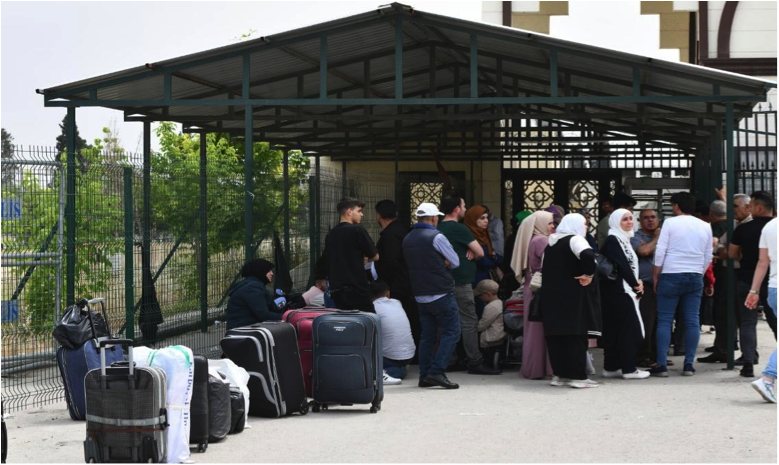The global refugee crisis has resulted in forced migrations, with individuals seeking refuge across borders due to economic, political, or climatic reasons. Jordan has been a significant host country for Syrian refugees, hosting the second-highest share of refugees per capita in the world (UNHCR,2023) where the United Nations High Commissioner for Refugees (UNHCR) and other humanitarian organizations to provide assistance in various forms.
Syria remains the world’s largest displacement crisis. More than 13 million people have either fled the country or are displaced within its borders (UNHCR, 2022).
While there have been reports of Syrians returning to their homeland, primarily driven by family reunification, the numbers remain relatively small. anecdotal evidence that suggests that senior relatives go back despite an active conflict for family reunification, to identify return conditions, or to guard property against appropriation risk (The World Bank,2019).
However, numerous challenges hinder the majority of Syrians from returning to Syria, including the absence of a political solution(Yet, Syrian refugees do not feel safe returning to Syria if Assad remains in power [1], growing despair, and a lack of trust between the Syrian people and the regime, despite the government’s declaration of a general amnesty. without a political solution, refugees and displaced persons will not return.[2] Additionally, the economic situation and the ongoing economic blockade on Syria further discourage mass return.
-
Waiting for a Solution and Political Decision for Syria: One of the primary reasons Syrians are hesitant to return to their homeland is the absence of a clear solution and a political decision that can ensure stability and safety(Baas,2018). The Syrian conflict has been ongoing for years, causing widespread destruction and displacing millions of people. Until a sustainable peace agreement is reached and a viable political solution is established, many Syrians fear the potential risks and uncertainties that come with returning.
-
Despair and the Loss of Hope: As the conflict persists, Syrians living in neighboring countries like Jordan can grow increasingly disillusioned and desperate for change. The protracted nature of the crisis, coupled with limited prospects for improvement, erodes hope for a better future in Syria. This sense of despair can lead many to believe that their chances of rebuilding their lives are greater outside of Syria, even with the challenges they face as refugees(NRC,2016).
-
Lack of Trust in the Regime: While the Syrian government has announced a general amnesty, there remains a significant trust deficit between the Syrian people and the regime (Jordan et al. ,2022). The prolonged conflict, human rights violations, and widespread displacement have created deep-seated mistrust among Syrians. Rebuilding trust and ensuring the safety and well-being of returnees are crucial factors that need to be addressed before Syrians will consider returning to their country.
-
Economic Challenges and the Economic Blockade: The economic situation in Syria presents a significant obstacle to the return of refugees. The Syrian pound has plummeted in value, causing hyperinflation and making it extremely difficult for individuals to support themselves and their families (UNCHR,2023b and UN,2021). Additionally, the economic blockade imposed on Syria by various countries further exacerbates the financial hardships faced by those living in the country. These economic factors contribute to the perception among Syrians that returning would not provide them with the stability and economic opportunities they seek.
While some Syrians have returned to Syria from Jordan, the overall number remains relatively small, with family reunification being the primary driving force (UNHCR, 2023a). A significant number of Syrian refugees had indeed preferred to stay in Jordan, despite the country facing resource constraints and limited capacity to accommodate large refugee populations. (Omari,2023)
The challenges of waiting for a political solution, growing despair, lack of trust in the regime, and the economic hardships faced by Syrians make it unlikely that a significant number will return in the near future. The global community must continue working towards a sustainable political resolution, addressing the concerns of the Syrian people, and creating the necessary conditions for a safe and voluntary return of refugees. Until then, it is vital to provide support and assistance to Syrian refugees in host countries to ensure their well-being and access to essential services.
[1] https://www.usip.org/publications/2023/03/syrias-stalemate-has-only-benefitted-assad-and-his-backers
[2] https://www.eeas.europa.eu/eeas/syria-ten-years-we-still-need-political-solution-addresses-root-causes-conflict_en
References
-
Omari, Raed (2023): Fewer than 1 percent of Syrian refugees in Jordan want to return home: UNHCR study. Arab News. https://www.arabnews.com/node/2325016/middle-east
-
Baas, Saskia (2018): The Real Reasons Why Syrians Return to Syria. The New Humanitarian.https://deeply.thenewhumanitarian.org/refugees/community/2018/03/06/the-real-reasons-why-syrians-return-to-syria
-
Borrell ,Josep (2021): Syria: ten years on we still need a political solution that addresses the root causes of the conflict. https://www.eeas.europa.eu/eeas/syria-ten-years-we-still-need-political-solution-addresses-root-causes-conflict_en
-
International Bank for Reconstruction and Development / The World Bank (2019): The Mobility of Displaced Syrians. An Economic and Social Analysis. World Bank Group. NW, Washington, DC 20433, USA. https://www.google.com/url sa=i&rct=j&q=&esrc=s&source=web&cd=&cad=rja&uact=8&ved=0CAIQw7AJahcKEwiQqcv9pp2AAxUAAAAAHQAAAAAQAg&url=https%3A%2F%2Fdata.unhcr.org%2Far%2Fdocuments%2Fdownload%2F67876&psig=AOvVaw3zj9-LTorRdLw5KlhXt-rI&ust=1689942842914679&opi=89978449
-
Jordan, Ashley , Samy Akil, Karam Shaar (2022):Data shows nowhere in Syria is safe for return. Operations & Policy Center. Middle East Institute.https://www.mei.edu/publications/data-shows-nowhere-syria-safe-return
-
Norwegian Refugee Council NRC (2016): DRIVERS OF DESPAIR. refugee protection failures in Jordan and Lebanon.
-
UN (2021): Escalating Conflict, Deepening Economic Crisis in Syria Pushing Humanitarian Needs to Highest Levels Since Start of Conflict, Senior Officials Tell Security Council. Meetings Coverage and Press Releases.https://press.un.org/en/2021/sc14612.doc.htm
-
UNHCR (2022): Eleven years on, mounting challenges push many displaced Syrians to the brink. https://www.unhcr.org/news/briefing-notes/eleven-years-mounting-challenges-push-many-displaced-syrians-brink
-
UNHCR (2023): Jordan. https://www.unhcr.org/countries/jordan
-
UNHCR (2023a): Eighth Regional Survey on Syrian Refugees’ Perceptions & Intentions on Return to Syria. Egypt, Iraq, Lebanon, Jordan.
-
UNHCR (2023b): Syria situation. https://reporting.unhcr.org/operational/situations/syria-situation
-
Yacoubian, Mona (2023): Syria’s Stalemate Has Only Benefitted Assad and His Backers On the conflict’s 12th anniversary, everyday Syrians face a dire humanitarian situation, while Assad’s grip on power holds steady. https://www.usip.org/publications/2023/03/syrias-stalemate-has-only-benefitted-assad-and-his-backers


